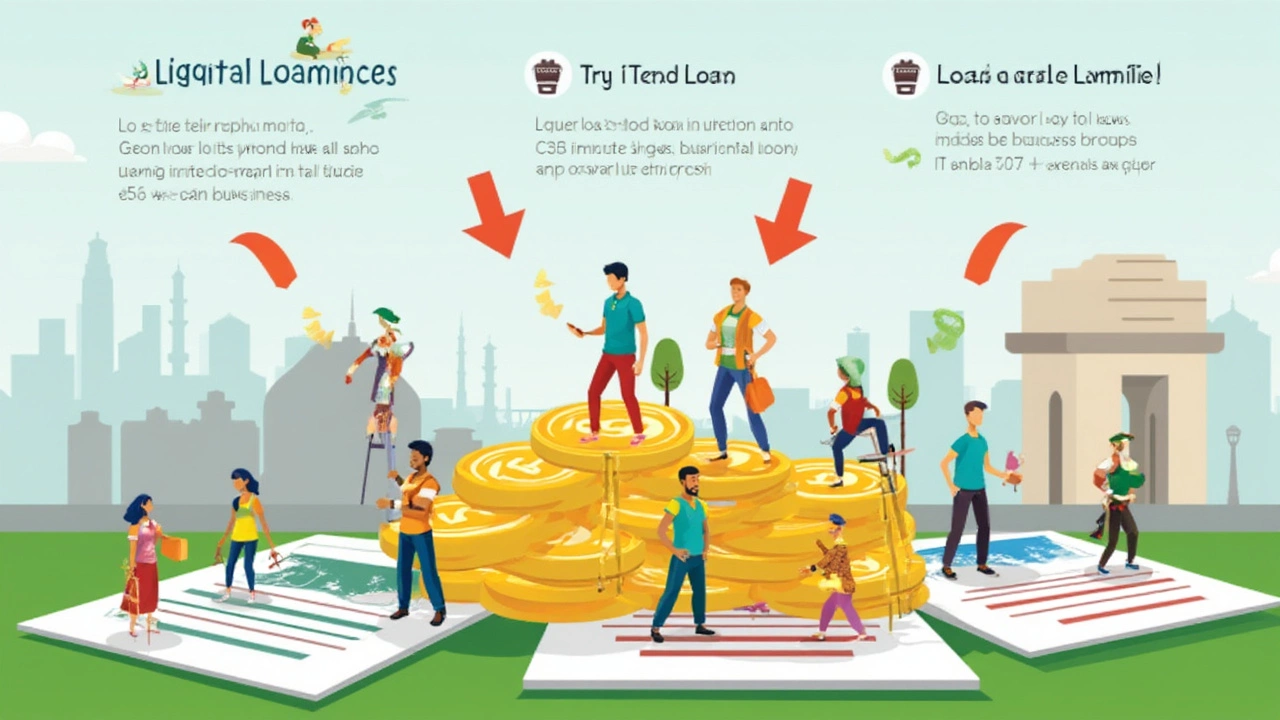Imagine you’re ready to grow your business, but you hit a wall—cash flow is tight, and your plans need funding. You’re not alone. Every year, Indian entrepreneurs take out crores in loans to power up their ventures, but picking the right kind of loan? That’s where most people sweat. Forget scrolling endless pages of bank ads; let’s get real about which business loan fits you best and how to snag it without headaches.
Understanding Your Business Loan Options in India
The Indian lending landscape isn’t just about traditional bank loans anymore. From young fintech startups to government-backed offers, there’s a buffet of choices for every business size. But knowing what’s on the table is half the battle.
First off, you’ve got best business loan India options split into secured and unsecured loans. Secured loans want you to pledge assets like property or inventory; banks basically trust you more if you put something valuable on the line. Unsecured loans don’t demand collateral—great if you’re asset-light, but banks hike up the interest rates as the risk goes up. There are also working capital loans designed to help you bridge short-term gaps—think paying suppliers or making payroll while you wait on payments. Term loans are all about long-term plans: machinery, expansion, renovation, you name it. Overdrafts work like a buffer on your account, letting you dip into extra funds without a full-blown loan process.
If you’re in the SME (Small and Medium Enterprises) game, you’ve got access to special loans like the Pradhan Mantri Mudra Yojana for micro-enterprises. Startups have startup loans—these are tough to get but possible, especially from government or fintech lenders. Invoice financing is another cool one; you can get cash based on bills you’re waiting to be paid. That’s a lifesaver for B2B companies dealing with slow-paying clients.
Here’s a quick snapshot:
| Loan Type | Secured | Interest Rate (2025 Avg.) | Purpose |
|---|---|---|---|
| Term Loan | Yes/No | 8-14% | Expansion, assets, long-term plans |
| Working Capital | Usually No | 9-16% | Day-to-day operations |
| SME/MSME Loan | No | 10-18% | Business development, stock |
| Invoice Financing | No | 10-20% | Based on outstanding invoices |
| Mudra Loan | No | 8-12% | Micro-enterprise funding |
| Startup Loan | Maybe | 12-20% | Early-stage business costs |
See the difference? Your pick will depend on what you’re trying to do and what you can put up as security.
Comparing Government Schemes vs. Private and Bank Loans
This is where things get interesting. Government schemes can be a goldmine if you qualify. Take Mudra Loans: Tiny businesses can get up to Rs 10 lakh here, aimed at women, micro-units, and rural entrepreneurs. The catch? Expect red tape and paperwork. If you’re patient and tick their boxes, you might enjoy low rates and easy repayment terms.
SIDBI’s (Small Industries Development Bank of India) startup loans and Credit Guarantee Fund Trust for Micro and Small Enterprises (CGTMSE) let you borrow without property as collateral. There’s risk mitigation for banks built in, which tricks down to you. Banks will lend you money even if you don’t own a building, as long as your plan stacks up. Still, approval takes time, and paperwork is king.
On the flip side, private and NBFC (Non-Banking Finance Company) lenders go light on paperwork and fast-track your funding. A fintech lender might tell you yes or no in a day—and sometimes, without even meeting you. They make up for this speed by charging higher interest (sometimes up to 24%), but if your business can turn that loan around quickly and profit, the math can work in your favor. Some offer flexible repayments (weekly, monthly, turnover-linked), which is perfect if your sales are seasonal or unpredictable. Watch for hidden fees, though—processing, early closure, or even insurance you didn’t ask for.
Consider your time versus cost. If you need to fix a cash flow issue right now and can't wait for weeks of vetting, NBFCs or digital lenders could save your skin. If you’re planning a big expansion and can afford to wait, a government or public sector bank loan might leave more money in your pocket over the long run.

How to Qualify: What Lenders Really Want to See
It’s no secret: lenders love predictable, profitable businesses. If you show healthy turnover, stable or growing revenues, and solid paperwork, banks roll out the red carpet. But what if you’re new or irregular?
Banks and NBFCs look for:
- Business stability: At least 2-3 years of operations is gold. Startups may need alternate proof—like strong investor backing, unique tech, or big contracts pending.
- Turnover: Many banks want Rs 10-15 lakh per year minimum, but some fintech lenders have lower limits.
- Profitability: Black ink beats red. Consistent profits for a couple of years help, though not mandatory for every product.
- Credit history: A high CIBIL Score (above 700) makes your rates cheaper. Missed EMIs or defaulted loans? That’s a red flag.
- KYC and paperwork: GST filings, ITR (Income Tax Returns), bank statements, business registration, and sometimes proof of orders or invoices.
- Collateral (if secured): Title deeds, machinery invoices, gold, or inventory receipts.
- Sometimes, a personal guarantee or co-applicant (your spouse or partner in business).
Startup founders sometimes get creative: pitching to angel syndicates, using crowdfunding, or lining up letters of intent from big customers to bolster their application. You might also pair a loan with a credit line—a safety net for rainy days. This mix-and-match can up your approval chances with both public and private lenders.
Interest Rates, Processing Fees, and Hidden Charges: The Real Cost of Borrowing
Interest grabs headlines, but fees quietly chip away at your profits if you don’t watch out. Indian business loans advertise annual rates (called "reducing balance" or "flat rate"). Reducing balance is good—interest is charged only on what you still owe. Flat rates sound low but end up costing more over time.
Banks might sweeten the pot with rates as low as 8% (for secured loans) but rarely for unsecured ones. Most working capital and SME loans hover around 12-18%. NBFCs and digital lenders can shoot well above 20%. Processing fees clock in between 1-3% of your loan, plus GST. Some lenders slap on documentation fees, stamp duty, prepayment penalties (if you repay quickly), even legal opinions. Always ask for all-in costs, not just the sticker rate.
Here’s a table with ballpark numbers you’ll find for 2025:
| Lender Type | Typical Interest Rate | Processing Fee | Other Potential Charges |
|---|---|---|---|
| Public Sector Bank | 8-12% | 1-2% | Stamp duty, legal fees |
| Private Bank | 10-16% | 1.5-2.5% | Insurance, pre-closure |
| NBFC | 12-24% | 2-3% | Documentation, service fee |
| Fintech Lender | 15-24% | 2-3% | Convenience, fast track fee |
Insider tip: Always read the fine print and confirm the total outgo—sometimes, a “low” interest rate loan ends up costlier if fees stack up. Get a repayment schedule and run the numbers on an online EMI calculator, just to see if your cash flow can handle it.

Making the Right Choice: What Works Best for Your Business?
No one-size-fits-all loan exists. The best choice for a local manufacturer is not the best for a digital startup or a retail trader. Here’s how you can zero in on the right option for your business in India:
- If you run an established SME with property to pledge, a secured term loan from a public bank is hard to beat for rates and tenure.
- If you need cash to buy stock or cover bills till clients pay, working capital loans or invoice financing (especially from a fintech) are quick and don’t tie up assets.
- Running a micro-enterprise or a solo act? Mudra loans offer low-interest funds with minimum fuss, tailored to small-ticket needs.
- Launching a tech startup? Startup India, SIDBI, and some private banks like HDFC and Axis now have special programs for early-stage risk-takers—but you may need a solid pitch, business plan, and maybe collateral or a guarantor.
- No collateral, patchy credit, but urgent needs? NBFCs or online lenders might be pricey, but your approval odds are higher, and the process is less painful.
The smartest business owners don’t just chase rates. They weigh flexibility (repayment terms, top-up availability), processing speed (days versus weeks), and the trustworthiness of the lender. Consider how repayments will eat into your profits—and whether you can prepay without pain, if your fortunes rise.
To wrap it up, India’s loan market has never been so open or innovative, whether you’re a village kirana store or a city-based SaaS dreamer. Know your numbers, arm yourself with paperwork, shop around, and pick a loan that lifts your business—without weighing you down.

